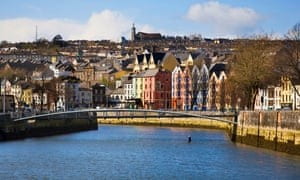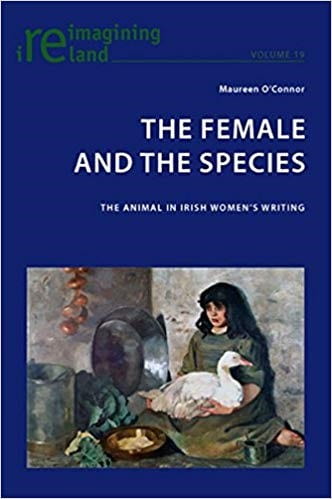Getting stuck in(to) the bog; Talking Wetlands and Culture in Cork – Dr Mary Gearey
Cork’s River Lee was in fine fettle as I walked along it at Pope’s Quay on the way to meet Dr Maureen O’ Connor at University College Cork’s School of English or Scoil an Bhéarla, to give it its Gaeilge (Irish) equivalent. A wet Spring meant water was in abundance, and the surrounding hills were the sparkling green of early Summer. Situated fifteen kilometres away from the coast, Cork city is shaped by its’ water networks. The central part of the city is an island surrounded by the river; and its’ nearby harbour is one of the largest natural inlets in the world, providing this Southern part of Ireland with transport and economic links with America and the rest of Europe. Cork’s Irish spelling Corcaigh means ‘marsh’ and the surrounding wetlands were the reason for my networking visit to meet Dr O’Connor, on a research trip generously funded by the University of Brighton’s Centre for Aquatic Environments.
 Figure 1: The River Lee, Cork city, Ireland
Figure 1: The River Lee, Cork city, Ireland
Dr O’Connor contacted me after I had presented a paper at the International Association for the Study of Ethnography and Folklore in Santiago de Compostela Spain in April this year. I had talked about wetlands as spaces of remembrance, memory and celebration as part of my NERC funded WetlandLIFE project work (www.wetlandLIFE.com). A central aspect of my work is the contemporary cultural representations of wetlands within England, and how our understandings and appreciation of these amazing natural environments are shaped by literature, song-writing, media, television, and films as well as through how we talk about wetlands in schools, universities and other learning spaces. Dr O’Connor’s recent research has also focused on contemporary Irish cultural appreciations of the more-than-human in the Irish psyche. She has worked on a feminist reading of animals in eco-criticism (see figure 2) and now explores the representation of wetland bogs in literature, music and other art forms – hence her contacting me to discuss future work together.
 Figure 2: Dr Maureen O’Connor’s 2010 monograph, the female and the species
Figure 2: Dr Maureen O’Connor’s 2010 monograph, the female and the species
Dr O’Connor’s work has explored the contradictions inherent to modern cultural depictions of Irish wetland spaces, which have often been viewed as worthless, bleak, useless and redundant. She has considered how much these bogs become symbolically the ‘bogeymen’ for the end of the recent Tiger Economy in Ireland. As these physical ecosystems filter air and water quality as part of their regulating and provisioning ecosystem services functions, she suggests so too do they metaphorically absorb the national ennui during times of economic downturn. Dr O’Connor argues that there is a connection between the ways that modern Ireland rejects bogs, viewing these spaces as financial sinks – in other words they make nothing, sell nothing, cannot be built on and so are worth nothing – and an attendant degradation in both the health of these wetland spaces and in the national psyche in terms of self-esteem.
 Figure 3: Leahill Bog, County Cork, Ireland (photo credit: Patrick Crushell)
Figure 3: Leahill Bog, County Cork, Ireland (photo credit: Patrick Crushell)
Our work connects over an interest in the ways in which counter cultural practices subvert the mainstream when we consider human and more-than-human relationships. The blanket and raised bogs of Ireland feature heavily in songs, folk-lore, fairy stories and fiction, often as ‘othering’ spaces of delinquency, retribution, magic and transmutation. This is true too of my research findings on the WetlandLIFE project, where sub-genres of fiction, poetry and nature writing, film-making, art performances and community activism reinvigorate our appreciation of wetlands spaces – and particularly often unloveable and hard to traverse bogs, moors, fens and heaths. These are magical spaces, in all senses of the word, and Dr O’Connor’s and my work seek to amplify the worth of these spaces through highlighting the playful and imaginative encounters that are taking place physically and figuratively within wetlands. We both feel that encouraging people to value wetland spaces can only serve to help protect them and enable people to value the natural world and themselves, and to disconnect from the ephemerality, and dark fiction, of economic peaks and troughs.
It wasn’t all chin stroking and welly wearing though. Later the next day, back on dry land, we watched the Munster finals of the Gaelic Football championships; Corcaigh (Cork) vs Ciarrai (Kerry). Much to the delight of my compatriots the ‘Kingdom’ (i.e. Kerry) won and compulsory celebrating was initiated. That night, back in the hotel, I dreamt of moonlight on a mountain tarn, deep in MacGillyCuddy’s Reeks, the night alive with lapwings and the gentle gurgle of a bogside stream…and awoke to a dripping shower and the prospect of an early morning flight.
